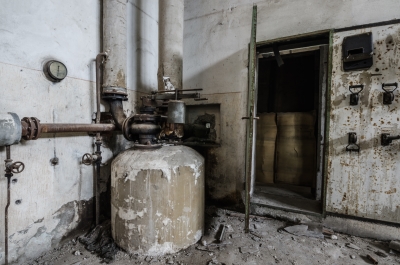Asbestos Boilers: Exposure, Risks & Legal Help
Boilers have long played a vital role in heating systems across industrial, commercial, and residential settings. Before the 1980s, many boilers were made with asbestos, a material known for its ability to resist heat and provide insulation. Although asbestos improved boiler efficiency, it is well known that breathing in fibers can cause asbestos-related diseases like mesothelioma.
As a result, boiler workers and others who maintain, install, or repair asbestos boilers face an elevated risk of developing these life-threatening diseases. Learn how exposure from asbestos in boilers puts workers at risk and what legal options for compensation exist.
Asbestos Boilers at a Glance
- Asbestos in boilers was primarily used for insulation, fireproofing, and durability until the 1980s.
- Boiler asbestos exposure can lead to mesothelioma, lung cancer, and other asbestos-related diseases.
- High-risk occupations include boilermakers, shipyard workers, railroad workers, and military personnel.
- Older boilers (pre-1980s) with certain insulation types are still likely to contain asbestos.
- Mesothelioma victims can seek compensation through lawsuits, asbestos trust funds, workers' compensation, and VA benefits.
Asbestos in Boilers

For decades, asbestos was widely used in boilers for insulation, fireproofing, and efficiency. However, its widespread use has resulted in significant health risks for boilermakers, homeowners, and others exposed to deteriorating asbestos materials. A boiler’s purpose is to heat water and to either provide hot water or steam for heating.
Hot water boilers provide heating and hot water in residential, commercial, and industrial settings, including:
- Breweries
- Commercial buildings
- Food processing plants
- Homes
- Hospitals
- Hotels
- Manufacturing plants
- Schools & universities
Steam boilers produce steam to power turbines for electricity and support industrial heating applications. Examples of industries that commonly use steam boilers include:
- Chemical
- Food and Beverage
- Military (naval ships, bases)
- Oil and Gas
- Paper and Pulp
- Pharmaceutical
- Power Generation
- Textile
Common Asbestos-Containing Boiler Parts
Asbestos was commonly used in boiler parts throughout the 1970s because it had several helpful qualities:
- Heat Resistance: Withstood high temperatures to maintain energy efficiency.
- Fireproofing: Helped reduce fire risk in places where boilers were used.
- Strength and Durability: Made boiler parts more resilient to heat and pressure.
- Low Cost: Offered an inexpensive solution for insulation needs.
Older boilers often used asbestos in the following parts and materials:
- Boiler Insulation: Asbestos was used to cover boiler doors, the inside of the boiler, and the outer shell.
- Cement and Coatings: A mix with asbestos was used as a coating on boiler surfaces to protect them.
- Gaskets and Seals: Asbestos gaskets helped create tight seals in joints.
- Pipe Insulation: Many pipes were wrapped with asbestos insulation, which often looked like white, ridged material.
- Valves and Pumps: Some valves and pumps used asbestos-based materials for sealing and packing.
Manufacturers of Asbestos Boilers and Parts
Many boiler manufacturers used, sold, and installed asbestos-containing materials in their products even after learning about the health risks. Boiler workers and others exposed to this toxic mineral and diagnosed with mesothelioma may be eligible to pursue legal options, such as filing an asbestos lawsuit.
Historically, these companies manufactured boilers that incorporated asbestos into their boiler designs to enhance durability and heat resistance. Notable companies include:
- A.O. Smith Corporation
- Allis-Chalmers Manufacturing Company
- American Standard, Inc.
- Babcock & Wilcox
- Burnham Corporation
- Cleaver-Brooks
- Combustion Engineering
- Crane Company
- Crown Boiler Company
- Foster Wheeler Corporation
- Ingersoll Rand Company
- John Crane Inc.
- Kewanee Boiler Corporation
- Riley Stoker Corporation
- Weil-McLain Company
- Yarway Corporation

A complete guide delivered next day to your doorstep. Treatment Information, top doctors & cancer centers, financial assistance and more.
Health Risks From Asbestos Boiler Exposure
By the 1970s, it was widely recognized that inhaling airborne microscopic asbestos fibers during installation, repairs, or removal, could lead to serious health problems. One of the most severe conditions linked to exposure is mesothelioma, a rare and aggressive cancer.
In March 2024, the EPA issued a full ban on chrysotile asbestos, the most widely used type, under the updated Toxic Substances Control Act. This legislation aims to reduce health risks across multiple industries. Since the 1970s, the use of asbestos-insulated boilers and similar products has declined and, in many cases, been restricted. However, many older systems still contain asbestos.
Mesothelioma, lung cancer, and other asbestos-related diseases often take decades to appear. This long latency period makes early detection and strict safety measures essential for anyone working around asbestos in boilers or related components.
Who Is at Risk?
Certain occupations face a higher risk of asbestos exposure due to their work with boilers. Many of these workers come into contact with asbestos insulation, gaskets, and cement directly, leading to long-term, exposure-related health risks.
Until the 1980s, there was widespread use of asbestos resulting in exposure among workers, especially those in boiler repair, maintenance, and manufacturing. As a result, many workers later developed serious illnesses like mesothelioma. While regulations prohibit the use of asbestos in newly manufactured boilers, it can still be found in many older boilers still in operation today posing an exposure risk to workers involved in maintenance and repairs.
Some common occupations and examples of applications of direct asbestos exposure while working on or around boiler units include:
- Boilermakers: Assembly, installation, and repair of boilers, as well as frequent work with asbestos-containing materials such as gaskets, seals, and insulation.
- Insulators: Application of spray-on, wrap, and block insulation to boilers and connected piping.
- Railroad workers: Regular maintenance and repairs of boilers in locomotives.
- Shipyard workers: Ongoing installation, maintenance, and repair boilers on ships and in shipyards.
Other notable occupations at risk of inhaling hazardous asbestos fibers from old asbestos-lined boilers include:
- Construction workers
- HVAC workers
- Machinist’s mates
- Maintenance workers
- Pipefitters
- Plumbers
- Power plant workers
Navy veterans and other services members, particularly those that worked on boilers or in boiler rooms, are also in a high-risk category for asbestos exposure. For example, navy personnel regularly worked below deck in compact areas with poor ventilation. Boiler operators often maintained and repaired the insulation on boilers as well as other asbestos-containing materials.
Family members of those who worked on, or around asbestos boilers may have faced secondary exposure. Asbestos fibers could stick to work clothes and be carried home. Over time, this put others in the household at risk of mesothelioma.
How to Identify Asbestos in Older Boilers
If you suspect a boiler contains asbestos, consider the following indicators:
- Age of the Boiler: Units manufactured before the 1980s are more likely to contain asbestos.
- Insulation Type: Older insulation that appears like cement, fabric, or corrugated cardboard may contain asbestos.
- Manufacturer Records: Research boiler brands for historical asbestos use in their products.
- Warning Labels: Check for labels that state “Asbestos-containing” or “ACM.”
Identifying asbestos requires specialized testing by a certified professional. If you suspect your boiler contains asbestos, do not disturb it. Instead, take safety precautions and contact a qualified asbestos professional before handling, repairing, or removing it.
Mesothelioma Compensation for Asbestos Boiler Exposure
Manufacturers of boilers and suppliers of asbestos-containing materials have been sued by workers who later developed illnesses linked to asbestos exposure. Those diagnosed with an asbestos-related disease like mesothelioma due to boiler exposure may have legal options, including:
- Mesothelioma Lawsuits: Holding manufacturers, suppliers, and others responsible for asbestos exposure.
- Asbestos Trust Funds: Compensation available from bankrupt asbestos manufacturers.
- Workers’ Compensation Claims: Financial support for work-related asbestos exposure.
- VA Benefits: Assistance for military veterans exposed to asbestos during service.
Choosing a top mesothelioma law firm like Early, Lucarelli, Sweeney & Meisenkothen (ELSM) is essential for securing large settlements and handling legal matters so that patients can focus on their treatment.
Request a Free Case Evaluation
Request a free case evaluation now if you or someone you love has been diagnosed with mesothelioma. The evaluation will cost you nothing. Our lawyers will travel to visit you at your convenience or conference call with you over the phone. We understand how difficult a time this is for you and will assist in any way that we can. You can also call us toll-free at 1-800-336-0086 at any time.




